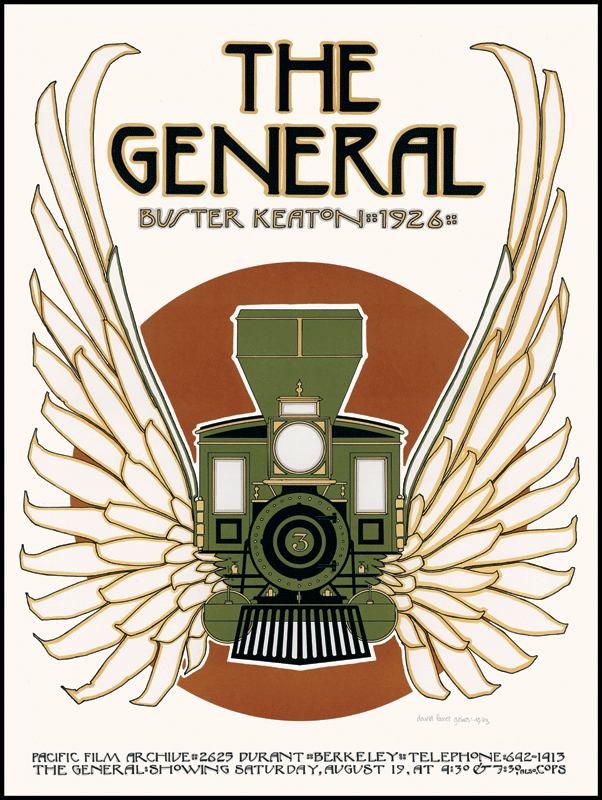 This week my attention was captured by the image of a train with wings and a short paragraph about a man who was kicked out of UC Berkeley at age 19, apprenticed with a traditional printing press and later bought the shop when the business went bust (Meggs', 459-450). This man is named David Lance Goines and his poster design for a screening of the Buster Keaton classic film The General seemed to merge elements of Plakatstil with Art Nouveau, two of my favorite styles. I was hooked and needed to see more than our text provided. And I needed to know what happened to him after launching the Saint Hieronymous Press and find out if he was still running it. As it turns out, the press is still running strong and has made quite an impression in Berkeley over the years. And he apparently has an amazing mustache!
This week my attention was captured by the image of a train with wings and a short paragraph about a man who was kicked out of UC Berkeley at age 19, apprenticed with a traditional printing press and later bought the shop when the business went bust (Meggs', 459-450). This man is named David Lance Goines and his poster design for a screening of the Buster Keaton classic film The General seemed to merge elements of Plakatstil with Art Nouveau, two of my favorite styles. I was hooked and needed to see more than our text provided. And I needed to know what happened to him after launching the Saint Hieronymous Press and find out if he was still running it. As it turns out, the press is still running strong and has made quite an impression in Berkeley over the years. And he apparently has an amazing mustache!
Goines is perhaps most widely known for his several decades of successful poster art, including the series promoting classic film screenings. His work has been reproduced in numerous publications, exhibited internationally, he has authored several books and he lectures frequently. Over the years he has created works for many local businesses, most notably Chez Panisse restaurant, for UC Berkeley, and many wine labels, a few of which I have personally enjoyed without ever knowing the artist behind them. I especially enjoyed his comments regarding the ATF rejection of his original label design for Kenwood.
Despite their name, they do not exist to promote these things, but rather to protect us from all three, preferably by eliminating them altogether. This design was originally done for Kenwood Winery as a wine label, but the ATF ruled that (and I quote) "the drawing of the young lady must be deleted. More specifically, the Bureau regards the picture as 'obscene or indecent.'"The full story, including the ATF approval 20 years later, is available on his official website.
OK. No naked dames. They said it would be acceptable if we put a black bikini on her. I didn't like that idea. Since we finally got them to admit that it was the skin, the naked skin, that offended them, I redrew the design and eliminated the skin. We then resubmitted Kenwood's label with a recumbent skeleton on a vineyard hillside. After a bit of hemming and hawing, the ATF rejected that design, too. Some song and dance about fetal alcohol syndrome. Hard to deal with an agency that can just make up rules as they go along.
I also really enjoyed getting a glimpse into the mind of Goines through this interview with Collectors Weekly.
I don’t collect posters. I don’t collect anything. I started making posters one at a time by hand in high school just for specific events, basically got going when I was a freshman. I still make them today, but they’re printed on a printing press now. I’ve made 221 posters, not including the ones I did in high school. Fundamentally, I believe that in order to be effective as opposed to artsy and not really effective at all, a poster has to be extremely simple.His humble description of what he does and how he does it is refreshing, and I find truth in his belief in the necessity for simplicity in poster design. He also shares some of his inspirations, thoughts regarding fine art vs. graphic art, and commentary on other contemporary design work.
Today Goines still runs St. Hieronymus Press and continues to print using traditional letterpress and photo-offset lithography techniques on an assortment of presses from the 1800s and early 1900s. According to this article in Oakland Local, Goines designs his posters using the following steps:
- Draws the design by hand.
- Traces the design on tracing paper and transfers it to a linoleum block.
- Carves the design into the linoleum block.
- Creates a print from the linoleum, and then scans the print.
- Uses Photoshop for some final processing, similar to how he used to use a dark room.
- Transfers the image back onto either an offset die or a letter press die, depending on how many colors the job requires and the size of the image.


No comments:
Post a Comment